Geisel is, of course, the real name of the kids book author, Dr. Seuss. I love the way he used to draw hands. I've blogged about this subject before, but I thought it might be worth revisiting if I added photos of my own hands to help make my points.
Geez, this hand (above) is brilliant. It would belong in a cartoon museum if there was such a thing. What would you call it? A caricature of a hand?
Hmmm...well, not exactly. Real hands (above) don't look at all like the kind Geisel drew. Geisel's hand has long, breadstick fingers and elegant sweeping lines. It's so different than a real hand that "caricature" doesn't seem to describe it.
Here's (above) another Geisel hand. It looks gnarly and boney and...I'm searching for the word...deep-fried. It's less a caricature of a hand than a rethinking of what a hand is.
A real hand (above) is a multi-purpose tool that can be used for pointing and a hundred other things. That's all fine and good but Geisel favors the hand that's tailor-made for a task, and so do I. Geisel's deep-fried hand is a specialty tool. It's meant for pointing and nothing else. It would be no good for holding a spoon and sipping soup.
In the course of a funny cartoon a character's hand design may change many times....yet, paradoxically, it still must recognizably be the same character's hand. Interesting, huh?
Here (above) I'm guessing that Geisel just wanted to show how gnarly and ginger root-like a hand could be. Look at the joints and spots and wrinkles and hairs. Look at the weird bend in the thumb. Whatever the hand is pointing to is probably less interesting than the hand itself.
For comparison, here's (above) a real hand. How boring! In order to make interesting hands the Geisel way it might help to ask, "What is a cartoon hand for?" The answer is, it's for spilling and dropping, for scratching an itch, for insulting others with gestures, and for quirky, independent behavior that embarrasses its owner.











 Sometimes interesting hands require interesting, quirky arms like the ones on this Ted Geisel drawing (above). It's great how a single hand can suggest the way a whole character should be drawn. That's because the hand was non-standard. Drawing standard body parts dulls the imagination.
Sometimes interesting hands require interesting, quirky arms like the ones on this Ted Geisel drawing (above). It's great how a single hand can suggest the way a whole character should be drawn. That's because the hand was non-standard. Drawing standard body parts dulls the imagination.


